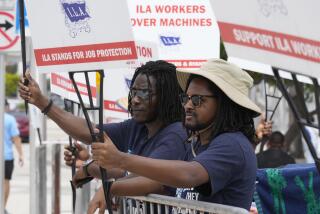Talks Lag, but Not Dockworkers’ Spirit
For longies--as the longshoremen are known--it’s a memory that still burns: a July 5, 1934, clash between police and waterfront picketers in San Francisco that left two longshore workers dead and a hundred injured. It’s called “Bloody Thursday.”
Ever since, longshore workers from Seattle to San Diego have taken the day off each July 5 to honor those who fought and died to establish the International Longshore and Warehouse Union.
This year, however, with tough contract talks between the ILWU and Pacific Maritime Assn. limping along, the picnic attended by 1,200 dockworkers and their families at San Pedro’s Peck Park on Friday was more than just another observance of Bloody Thursday.
Emboldened by the resolve of workers nearly seven decades ago, union members and pensioners--some of them wearing the trademark white short-brim caps of their founder, Harry Bridges--pushed beyond platitudes about solidarity and got to the heart of the union born out of battle.
“You don’t come into the ILWU’s backyard and start taking jobs and benefits away from people who spilled blood for them,” said Ramone Ponce De Leon, president of the union’s 4,500-member Local 13. “Here, the employers are not just facing the ILWU. They’re also facing the community that depends on port industry.”
That kind of talk suggests that “68 years later, Bloody Thursday is stiffening peoples’ backbones,” said Harvey Schwartz, curator of the ILWU’s oral history archives. “With contract negotiations at an impasse, its mythology and symbolism live on in an understanding that there is grim, serious business to be done.”
On Monday the contract expired between the 10,500 longshore workers and mostly foreign-owned shipping lines who move $260 billion of cargo a year on West Coast ports. Now, representatives on both sides of the bargaining table are trying to resolve their dispute and avoid a strike or lockout that could cripple the nation’s economy.
The most sensitive issues include employers’ desire for new automation and computerization that could outsource longshore jobs. On Monday, negotiators will travel from San Francisco to the Los Angeles-Long Beach port complex to examine the ways in which information is processed, and the people who process it.
“No one in this park today is seeking huge wage increases,” said Assemblywoman Jenny Oropeza (D-Long Beach. “They’re just trying to protect their livelihoods and benefits in an industry that is a family tradition.”
It is hard for a union member to go anywhere in the blue-collar wharf communities of San Pedro or Wilmington without bumping into that tradition. Some stores still carry those white Harry Bridges caps. A year ago, the Los Angeles Maritime Museum organized an exhibit of historical photographs and documents supplied by the union.
A monument marks the spot near the port’s Berth 145 where Dickie Parker, 20, of San Pedro and John Knudson, 43, of Lomita were shot to death on May 15, 1934, by guards hired by the shipping lines.
Last July, a celebration of Bridges’ 100th birthday culminated in a two-mile parade over the Vincent Thomas Bridge from Terminal Island to San Pedro.
The contest for control of West Coast docks began back in the early 1920s, when cargo was packed loose by hand and hauled on and off ships on men’s backs.
Prominent among the new faces on the docks at that time was tough, hawk-faced Bridges, a militant organizer of the newly formed International Longshore Assn.
The stage was set for a waterfront showdown in 1933 when shippers--who decided who worked and who didn’t through an employer-controlled hiring hall or dockside “shape-ups”--refused to negotiate with the ILA.
At 8 p.m. May 9, longshore and warehousemen from Bellingham, Wash., to San Diego walked off the job. Employers brought strikebreakers and used political muscle to force police intervention.
A total of six workers in San Francisco, Seattle and San Pedro were shot or beaten to death by police or company goons during the course of the strike. Hundreds of others were injured.
The National Guard was called in to stop the violence. Bridges turned down a $50,000 bribe to back off from the dockers’ demand for a hiring hall.
ILA members won support from unions up and down the coast for a general strike in San Francisco that lasted four days but shifted the balance of power. Longshoremen won a coast-wide agreement that included a union hiring hall, shorter hours, safer conditions and a raise of 5 cents an hour.
The ILA broke apart as the ILWU took shape amid an invigorated West Coast labor movement.
West Coast docks suffered additional strikes in 1936-’37, 1948 and 1971, when dozens of incoming ships were forced to anchor offshore.
For now, neither side is talking about a strike or lockout. They have, however, agreed to several short-term extensions of their talks. But as tensions mount, old-timers with the union have been urging younger workers to keep the culture of 1934 alive.
“Our job today as union members is to protect and save all that was won and passed on to the present work force,” said pensioner Art Almeida, 73.
“How do we impress that upon the younger generation?” he asked. “Kids today never had to struggle. Yet, it’s up to them.”
More to Read
Sign up for Essential California
The most important California stories and recommendations in your inbox every morning.
You may occasionally receive promotional content from the Los Angeles Times.











